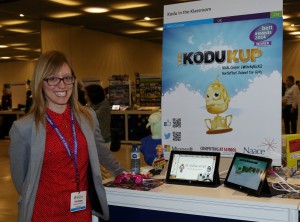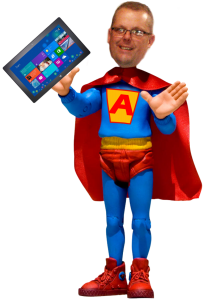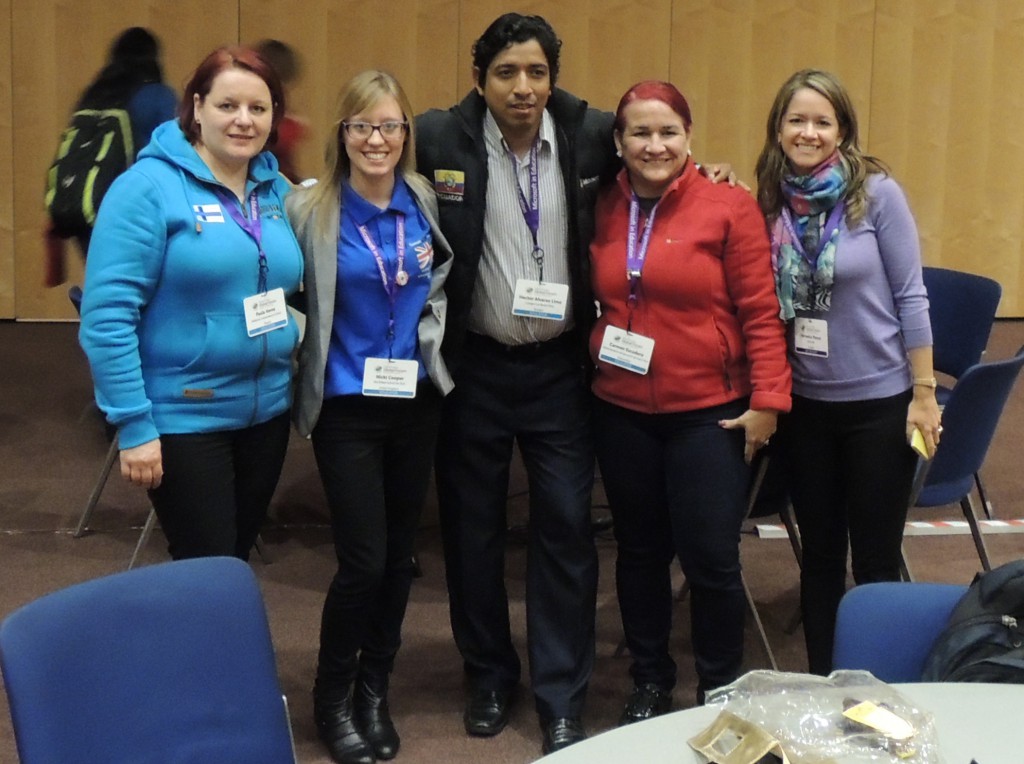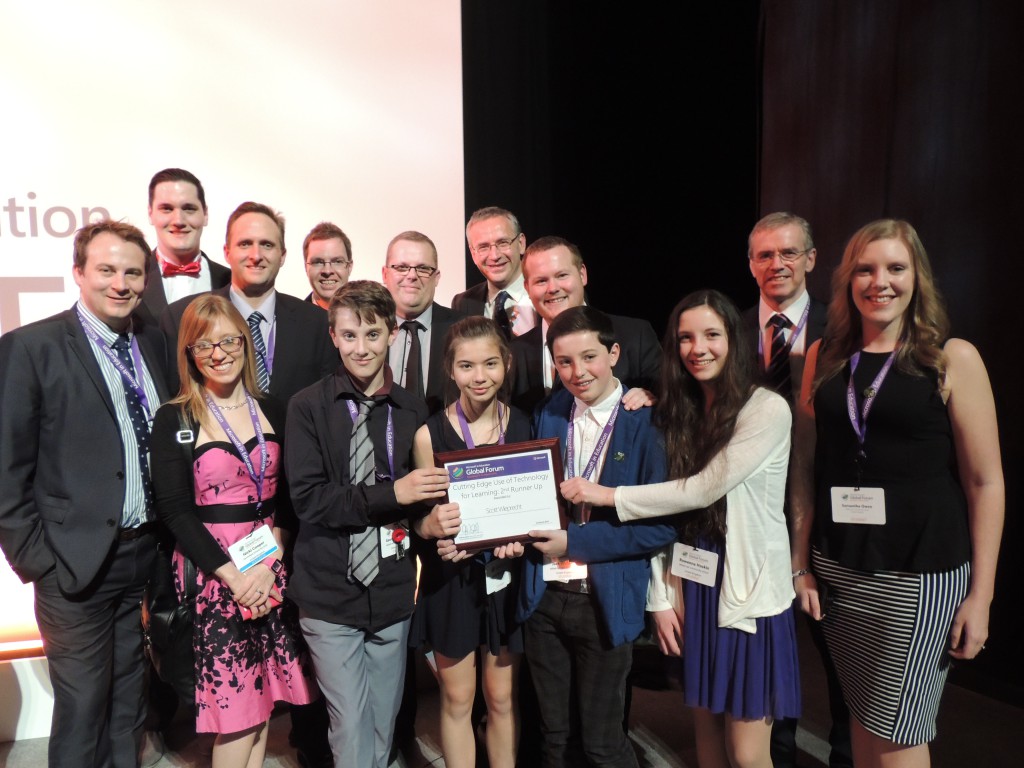 Last week I had the privilege of joining 250 educators from around the world in attending Microsoft in Education’s Global Forum in Barcelona. I arrived on Monday evening and was ready to set up my stand bright and early on Tuesday morning! I received my invitation to the event after winning an award at the previous Global Forum for my Kodu in the Klassroom project. All previous winners became Microsoft Innovative Expert Educators for a year (along with many others through a selection process) and I was there to showcase the progression of my project over the past year. Throughout the rest of the day we were given a few different talks and took part in a team building exercise with the groups with which we’d be working later in the week.
Last week I had the privilege of joining 250 educators from around the world in attending Microsoft in Education’s Global Forum in Barcelona. I arrived on Monday evening and was ready to set up my stand bright and early on Tuesday morning! I received my invitation to the event after winning an award at the previous Global Forum for my Kodu in the Klassroom project. All previous winners became Microsoft Innovative Expert Educators for a year (along with many others through a selection process) and I was there to showcase the progression of my project over the past year. Throughout the rest of the day we were given a few different talks and took part in a team building exercise with the groups with which we’d be working later in the week.
First Day Highlights

One highlight of the first day was the talk from “App Man” himself, Stuart Ball, talking about various apps that are available on Windows 8 devices, check out his blog post for the full roundup. Some of my favourites are:
- OneNote - One of the best applications for educators, in my opinion, both the desktop and mobile versions are great. OneNote allows students and teachers to collaborate on projects and almost any file can be embedded within the pages. It certainly helps to keep me organised and I even use it for my lesson planning!
- Project Siena An app for creating apps (I’ll talk about this one in more detail further down as I explored this in some detail later in the week).
- NovaMind Mind Mapping – Great tool for mindmapping, there is a free version and you can upgrade to get more features.
- Createbook - App for creating ebooks and it’s free for one more day (until 21st March!).
- Corinth Classroom B– Look at different parts of the human body in detail.
- ChronoZoom– An app for creating interactive time lines.
- Code Writer (I discovered this while browsing) – This is a professional looking app to enable developers (or in my case students) to write code in 24 different programming languages with colour-coded support for each. I had a quick play with using HTML and it works very nicely.
Day Two
The following day was the start of the opening key note speeches which began with Jan Muhlfeit (European Chairman of Microsoft), Jan highlighted, for me the importance of my subject from a careers point of view, the fact that their are 900,000 ICT jobs in Europe that are not fulfilled is something I can certainly stress to the young people I teach. He also made an interesting point when he posed the question: “Is Mercedes a software company or a car company?”, the answer seems obvious but he pointed out that 60% of their budget is actually spent on developing software! I found this amazing and wondered how true this must be for many other businesses that we wouldn’t necessarily categorise as the “IT Industry”!
During the speeches we were also introduced to BizSpark which gives three years of free software, support, and visibility for startups. We also learnt about the Imagine Cup, which is a Global student technology competition with categories of Games, Innovation and World Citizenship and this has some great prizes to offer. Well worth checking out!
Next up was the much anticipated keynote by Anthony Salcito, Vice President of Microsoft Education Worldwide, he told us about Microsoft’s new CEO, Satya Nadella and his passion for education. Anthony delivered a very well thought-out scenario, demonstrating the use of some key technologies and tools and showed how they neatly synchronised between home and school from both a teacher and student’s perspectives. He showed so many interesting new and upcoming applications throughout his demonstration, it was difficult to keep up! Some particular highlights for me were:
- Lync, if you have Office 365 in school you will already have Lync. I have been using it myselft but wasn’t aware it had so many features. Anthony demonstrated that you can use this to create a collaborative drawing canvas, share the board, create polls and show the whiteboard. I need to go and play with it some more now!
- Project Spark– the next step up from Kodu, I’ve talked about this in a previous blog post.
- A Top Secret add in for PowerPoint which enables you to create rich and interactive content within the slide. I’ll share more on this as soon as I am able.
- Power Map for Excel, this enables you to plot data in a spreadsheet straight onto a map graphically.
- Class Policy, this is an app to take full control over the Windows 8 devices in your classroom.
He also demonstrated a fantastic use of Skype in school, shown in the video below:
Another thing I didn’t know is that on the Partners in Learning site there are curriculum resources posted every day that are themed around the Bing home screen.
On Wednesday the UK team introduced some of our European friends to the concept of a TeachMeet which was put together by Stuart “App Man” Ball and David Rogers. I worked with Ray Chambers to tell people about our experiences with the Hour of Code, while David Renton introduced us to xGames, a game that enables a teacher to make a quiz for their students to answer in groups using Xbox controllers, I hate to gloat but my team won his example quiz in the TeachMeet!
Learn-a-thon
The last couple of days brought us the Learn-a-thon; this was a 24 hour activity in which we were divided into groups with peers from different parts of the world to design a learning activity that displays innovative use of technology in the three Millenium Development Goals of Poverty, Sustainability and Gender Equality. Our group were asssigned Poverty and investigated the use of Project Siena to develop a tourism app to bring visitors to poorer parts of the world. Two of our group members were from South America(Puerto Rico and Ecuador) and they highlighted the fact that tourism is what is needed in their countries to combat poverty.
I have to admit, this was the part of the event that I had not been looking forward to but actually I found it to be a thoroughly enjoyable and worthwhile activity, despite the language barriers. I was very thankful for the Bing Translator app on my Surface which enabled myself and Paula from Finland to communicate with our two Spanish-speaking team-mates when our interpreter was not around. Here’s an overview of the project we came up with:
My role was to focus on using Project Siena, a tool for creating apps, to develop an example app that would be similar to what our students may produce. Once I got started (after watching a few tutorials on Youtube) I found it surprisingly easy to use and developed a semi-professional looking app by the end! Well done to the rest of Team 51 for all the effort you put in, even though we didn’t win the competition I’m really proud of the work we produced!
From left to right: Paula Vorne, Nicki Cooper, Hector Alvarez, Carmen Escudero and our Spanish interpreter!
Gala Dinner and Awards Ceremony
The event ended with the Gala dinner and awards ceremony and I was delighted that the OffPerts, Scott Wieprecht and his team of lovely students won an award in the category for “Cutting Edge Use of Technology”, I was also pleased that fellow team mate in Group 51 above, Paula Vorne, won an award in the same category for her use of Kodu in entrepreneurship. Here’s the whole of the UK educators team celebrating after the dinner:
Final Thoughts
So is there anything I would change about the event?
Maybe just one thing. In future events I would like to see more workshop-style activities run by my fellow educators (this is how the UK Forums used to be delivered). There could be different activities which we sign-up for, I know lots of people would have loved to spend time with my colleagues Ray, David and Simon to learn more about how to use TouchDevelop. I would have been happy to deliver a session on Kodu. I would also have loved to hear more about exactly how Zana from Kosovo was running her Technician club or how Todd’s students from the USA were creating their content. We had 250 “expert educators” present and I feel there was a lot more to be learned from one another. That’s my only criticism, as I’m not going to discuss the coffee (or lack of)!
Finally, some key messages and points to take home:
- A child able to read is 50% more likely to live beyond the age of 5
- Translation software is REALLY useful!
- Collaboration, collaboration, collaboration
- As teachers we need to give more power to students and trust them, to learn they have to be allowed to fail along the way
- Technology is nothing without great pedagogy
I’d like to close with the following quote from Anthony Salcito, Vice President of Microsoft Worldwide Education:
“Don’t make technology the star, make it a tool to create amazing learning experiences.”










 Do you want to enter the Kodu Kup check out our Facebook page -
Do you want to enter the Kodu Kup check out our Facebook page - 

 generation.
generation.










 So the time is nearly upon us . . . the deadline for entries for the Kodu Kup is fast approaching as all games must be submitted by 30th May. Before you can submit the games they will need to be exported from Kodu Game Lab, this is a very simple process, here is a video that shows how to export:
So the time is nearly upon us . . . the deadline for entries for the Kodu Kup is fast approaching as all games must be submitted by 30th May. Before you can submit the games they will need to be exported from Kodu Game Lab, this is a very simple process, here is a video that shows how to export:

 I also took the opportunity to take a look at the Microsoft App store. It was well populated, with apps for Gmail, Dropbox and Google Drive, as well as few apps I enjoy on my iPad including Adobe Photoshop Express and Bamboo Paper and, my favourite, a Spotify App. I started my playlist on the Surface and enjoyed the sound coming from its built in speakers. I think the speakers could be improved, as sometimes the sound seemed quite congested; with the headphone jack, though, this wasn’t a problem. I also found a mobile HTML editor, which let me work on some of my website projects. I was particularly impressed with this, as a preview of the side was on the left of the screen and the code on the right. The surface made great use of the large display.
I also took the opportunity to take a look at the Microsoft App store. It was well populated, with apps for Gmail, Dropbox and Google Drive, as well as few apps I enjoy on my iPad including Adobe Photoshop Express and Bamboo Paper and, my favourite, a Spotify App. I started my playlist on the Surface and enjoyed the sound coming from its built in speakers. I think the speakers could be improved, as sometimes the sound seemed quite congested; with the headphone jack, though, this wasn’t a problem. I also found a mobile HTML editor, which let me work on some of my website projects. I was particularly impressed with this, as a preview of the side was on the left of the screen and the code on the right. The surface made great use of the large display. I particularly like the USB port which the Surface boasts. It was great to be able to add things like a mouse, Portable Hard Drives and even Printers to the Surface, which gave it increased functions of a fully-fledged laptop!
I particularly like the USB port which the Surface boasts. It was great to be able to add things like a mouse, Portable Hard Drives and even Printers to the Surface, which gave it increased functions of a fully-fledged laptop!









 You may remember earlier this spring when we shared the story of George, Amy, Jack and Rowenna – the @OffPerts. These four students not only attended the Global Forum, but they also shared and communicated their ideas with the educators, school administrators and government leaders in attendance. They made a big impression, and they also won a second runner-up award, along with their teacher Scott Wieprecht, in the Cutting Edge Use of ICT for Learning category.
You may remember earlier this spring when we shared the story of George, Amy, Jack and Rowenna – the @OffPerts. These four students not only attended the Global Forum, but they also shared and communicated their ideas with the educators, school administrators and government leaders in attendance. They made a big impression, and they also won a second runner-up award, along with their teacher Scott Wieprecht, in the Cutting Edge Use of ICT for Learning category.  In addition to his Expert Educator mantle and award at the Global Forum, Wieprecht was recently named as a Silver Teaching Award Winner in the category of “Outstanding use of Technology in Education” by the Pearson Teaching Awards, which recognize the life-changing impact of an inspirational teacher on the young people they teach. Wieprecht was selected from over 20,000 nominations received this year.
In addition to his Expert Educator mantle and award at the Global Forum, Wieprecht was recently named as a Silver Teaching Award Winner in the category of “Outstanding use of Technology in Education” by the Pearson Teaching Awards, which recognize the life-changing impact of an inspirational teacher on the young people they teach. Wieprecht was selected from over 20,000 nominations received this year.












